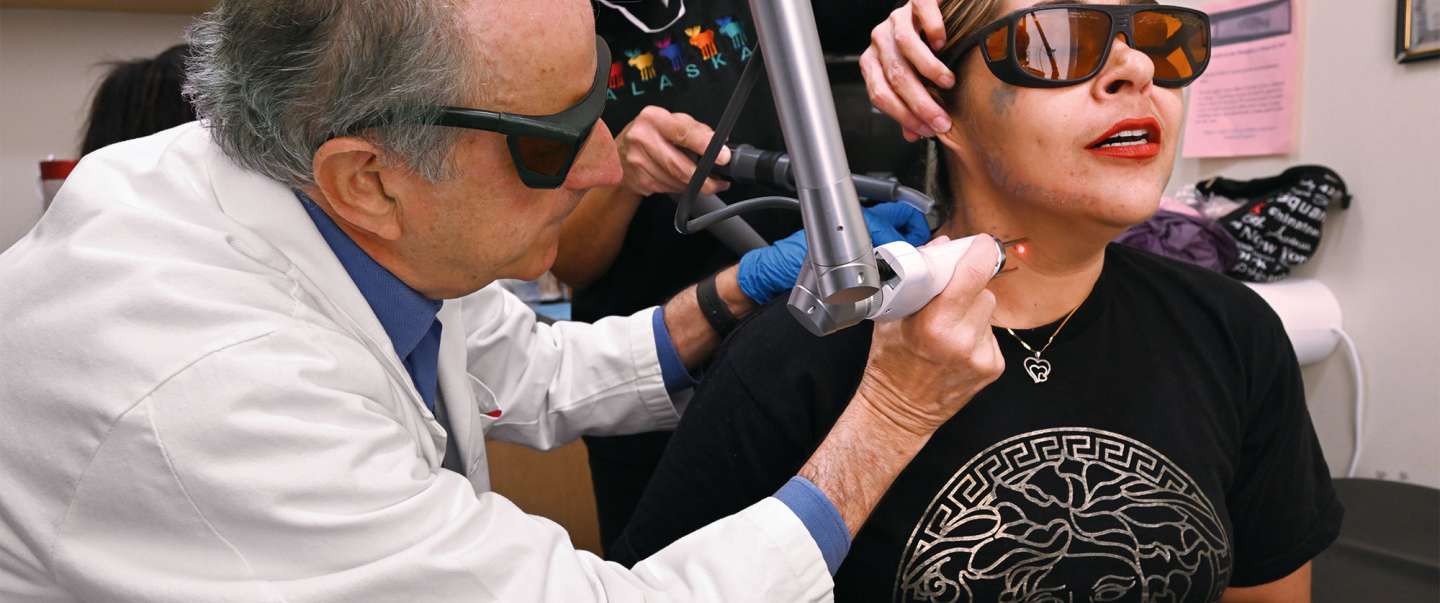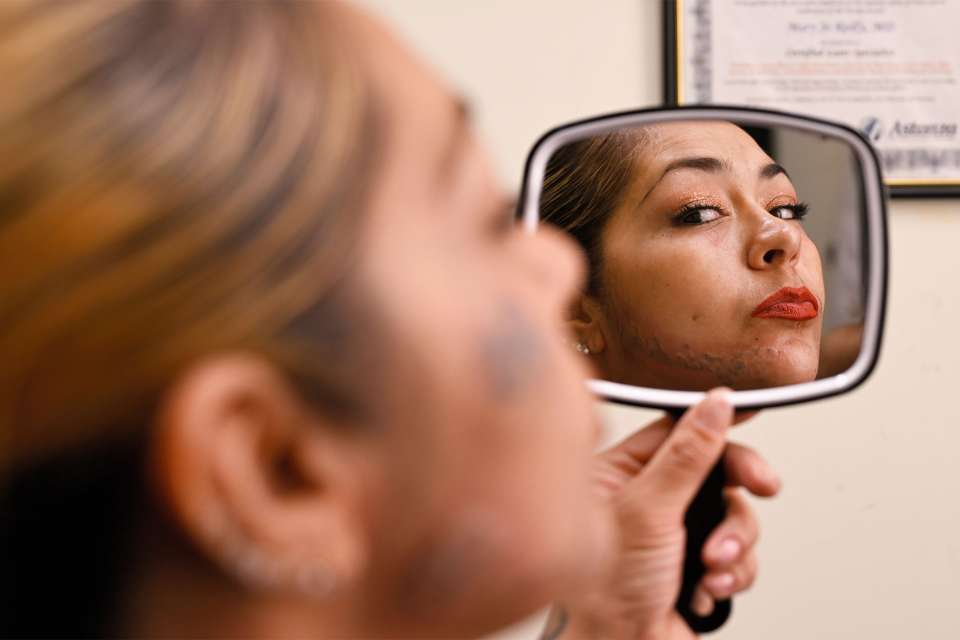
With tattoo removal, a doctor helps ex-gang members cast off their old lives
“SNAP! SNAP! SNAP!” goes the machine and Reyna Garcia winces in pain. A faint smell of something burning rises in the small room in the offices of Homeboy Industries, where a UCLA Health physician is using a laser wand to remove two five-inch-long cursive tattoos — remnants of a life she is leaving behind — from Garcia’s face.
When Garcia first started coming to Homeboy Industries near downtown Los Angeles, she had a lot more ink, including clown markings on her face: diamond shapes above and below her eyes and a black circle on her nose. After many visits, those tattoos are gone. Now, the script on either side of her face is growing more faint — practically illegible — after a series of treatments so painful that she cries during the procedure.
Robert Reiss, MD, a UCLA Health internal medicine specialist, is administering Garcia’s treatment. He began volunteering with Homeboy in 2019 and has been treating Garcia for more than a year.
“We’re almost done, kiddo,” he tells Garcia, as the red light from the three-pronged laser wand he’s holding traces the fading black ink on her face.
He and Garcia meet every eight weeks. Each time, Dr. Reiss takes a photo so Garcia can see the progression as her tattoos gradually disappear from her skin. “I’m going to have an anxiety attack!” Garcia says, only half-kidding, as she blows air out in quick exhalations, like a woman giving birth.
After her face, Dr. Reiss moves onto Garcia’s hand, where he’s removing the large ‘20’ inked there. Garcia decides not to treat the tattoo on her stomach today. Things have been painful enough already.
“See you in eight weeks,” Dr. Reiss tells her as she leaves. “I’ll email you.”
Dr. Reiss is no fan of tattoos, generally considering them to be “regrets in the making.” “I’ve joked that when I retire, I’ll open a tattoo-removal business right next to an ink parlor,” he says. “I’d call it, ‘What Was I Thinking?’”
He volunteered with Homeboy Industries after hearing a talk by Father Gregory Boyle, the nonprofit’s founder. Established in 1988, when Father Boyle was pastor of Dolores Mission Church in East Los Angeles, Homeboy today is the largest program in the country dedicated to rehabilitation of former gang members. During the talk, Father Boyle — or Father G, as he is commonly known around the Homeboy offices — told the audience, “We need people to remove tattoos. We want you.”
“I looked at my wife, and she looked at me, and the die was cast,” Dr. Reiss says.
Since he started volunteering, Dr. Reiss has spent every Tuesday — except for a brief period during the pandemic — at Homeboy Industries. He learned tattoo removal by observing another volunteer physician and went to conferences to further hone his skills. Finally, he started treating patients himself.

He has developed close relationships with many of the men and women he treats. “The process we’re going through together, it’s been amazing,” Garcia says. “I’m very grateful for him. He loves his job, and it comes out of him naturally. At the end of the road, it’s going to be a success because I’m going to be able to see myself with my clear face,” she says, adding she hopes her 4-year-old son won’t remember her with facial tattoos.
For Christopher Aviles, having the tattoos on his forearms removed is key to the new life he’s trying to create. The 30-year-old just graduated from college and completed Emergency Medical Technician training. “Getting my tattoos removed is giving me that clean-cut image that the L.A. County Fire Department wants,” he says. “It means so much to me, and I’m just very glad Dr. Reiss is doing this work.”
On a recent Tuesday, Dr. Reiss sees a new patient, a young man in his early 20s with a full sleeve of tattoos on his right arm, a large rose on the side of his neck and the word “Family” in cursive on the side of his face. That’s the one he wants gone. Dr. Reiss explains the two laser machines he will use in the process. “They don’t remove the ink,” he says. “What they do is break up the ink into smaller particles so your white cells can sweep them away.”
The stronger of the two machines will be used first, when the ink is most dense, Dr. Reiss says. The treatment can sometimes — though not usually — cause blistering, he explains. It makes the skin extra sensitive to the sun, so it’s important to cover the treated area with sunblock several times a day, he adds.
The patient doesn’t have any questions, so Dr. Reiss hands him a pair of protective glasses, puts a pair on himself and fires up the machine. “It’s going to hurt, buddy,” he says, patting the young man on the shoulder. Then he turns on the laser and the “SNAP! SNAP! SNAP!” begins.
Sandy Cohen is a senior writer in UCLA Health Communications and a former national writer for The Associated Press. Her article, “The Price,” received the Robert G. Fenley Gold Award for Excellence in Writing and the COVID Pivot Award from the Association of American Medical Colleges.
